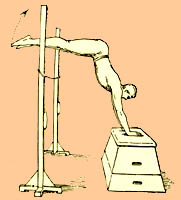 |
Climbing and Gymnastics A Historical Association |
 |
Climbing and Gymnastics A Historical Association |
The Late Victorians . . . a Few Examples Rock Climbing began as a sport in the late 1800s on the European Continent and in Great Britain. Bouldering began as an exercise for rock climbing at about the same time in England. To the extent that bouldering may be thought of as gymnastics itself, it constituted a very early form of such training for longer endeavors. But, it would appear that bouldering was not thought of as an extension of the gymnastics of that era. Nevertheless, there was clearly an interplay between gymnastic exercises and the sport of rock climbing. Gymnastic style training . . . Eckenstein . . . 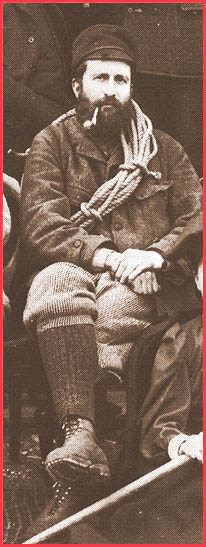 Among the earliest
references to gymnastic-level strength feats is one by Aleister Crowley in his Confessions:
Here's what Crowley had to
say, in the context of the 1890s : "He
[Oscar
Eckenstein] was a
finished athlete; his right arm in particular was so strong that he had
only to get a couple of fingers on to a sloping ledge of an overhanging
rock above his head and he could draw himself slowly up by that alone .
. .He was rather short and sturdily built." Crowley's
unreliability for accurate reporting notwithstanding, others did verify
that Eckenstein was very strong - although, perhaps, not quite this
strong! Among the earliest
references to gymnastic-level strength feats is one by Aleister Crowley in his Confessions:
Here's what Crowley had to
say, in the context of the 1890s : "He
[Oscar
Eckenstein] was a
finished athlete; his right arm in particular was so strong that he had
only to get a couple of fingers on to a sloping ledge of an overhanging
rock above his head and he could draw himself slowly up by that alone .
. .He was rather short and sturdily built." Crowley's
unreliability for accurate reporting notwithstanding, others did verify
that Eckenstein was very strong - although, perhaps, not quite this
strong!Eckenstein,
1890s
Geoffrey Winthrop Young, describing Pen-Y-Pass climbing gatherings during 1900 through 1914, says how the "casual visitor might enter to find Eckenstein hanging upside down by his hands on a rope." (This seems reasonable) Jones . . . And George Abraham tells a (ridiculously tall) tale about the incredible gymnastic strength of Owen Glynne Jones during the same time period, stating that Jones picked him up with one arm and did a one-arm pull-up on three fingers with the other arm on a horizontal ice axe. Very unlikely!
Jones himself comments occasionally (and presumably truthfully) about his training regimen. For example, with reference to his climb of the Walker Gully in the winter of 1898, he states : ". . . I blessed the previous three months' monotonous training with heavy dumbells". In Climbing Days (1935), the author, Dorothy Pilley, speaks of Jones' rumored feats: ". . . Owen Glynne Jones, hero of innumerable unemulatable acrobatic feats.. . .That he could pull himself up on the top of a door ten times by the tips only of those slim fingers . . . I had known for years.. . But that he could make a standing jump in climbing boots from one platform to another across a single line of rails was a new and wonderful item of information." (This seems a reasonable assessment of Jones' strength and dexterity) In The Heart of Lakeland (1908), L. J. Oppenheimer describes a typical scene: "Dinner over, the company is scattered about the hotel, yet every room seems crowded . . . Meanwhile the more energetic may be found in the Billiard Room . . . 'let's have the passage of the billiard table leg'. . . Only the gymnast succeeds; he begins by sitting on the table . . . he lets himself down gently, and, suddenly, twisting around, he braces his legs firmly against the cross-bars underneath . . . after a struggle his other hand and his leg appear on the opposite side of the table leg, and a moment afterwards he is sitting breathless on the table once more, amidst loud cheers." The gymnast was Owen Glynne Jones. There are other references to this feat. E. A. Baker (1903), speaking of an associate, comments " . . . an esteemed friend of mine keeps his muscular mechanism in order by ascending the outside of an iron staircase on his fingers, and, after a short 'stomach traverse', crossing in a sitting position the tie-bars of the lofty roof beneath which he is doomed to spend the intervals between his holidays." Haskett Smith wrote (ca. 1900) of a colleague, that he "had prodigious muscle power. I have seen him go up one edge of a house gable, over the ridge and down the other side, swinging by his fingers all the way from the edges of the slates." Gymnastics & Climbing in Late Victorian Times . . . Gymnastics . . . The late Victorian Period saw a considerable amount of gymnastic activity in England (and elsewhere in Europe), including formal competitions. Large universities, like Oxford, had competitive events such as the Oxford University Gymnastic Tournament, in which, e.g., a gold medal was won by G. E. Wollen in 1887. The following were several very active clubs during this period: Aberdeen Rowing and Gymnastic Club(1867), Northhampton Institute Gymnastic Club(1898), German Gymnasium at King's Cross, Perry Hill Gymnastic Club, Gymnastic Clubs at Battersea and Woolrich Polytechnics, Goldsmith's Institute, Borough Polytechnic, and Ealing School (girls & women). 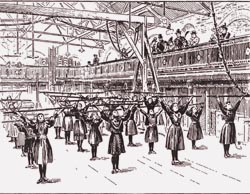 Battersea
was said to draw "its
gymnasts from all sources - clerks, gunsmiths, stonemasons, etc."
Each of these institutions, and many more like them, had scores of
active participants who
would come in two to four evenings during the week to train. These were
the "fitness
centers" of that time period. Some institutions had
several hundred athletes. Battersea
was said to draw "its
gymnasts from all sources - clerks, gunsmiths, stonemasons, etc."
Each of these institutions, and many more like them, had scores of
active participants who
would come in two to four evenings during the week to train. These were
the "fitness
centers" of that time period. Some institutions had
several hundred athletes. Ealing School, London, 1900 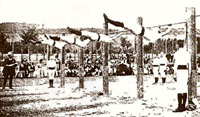 Apart
from the German-influenced
individual apparatus exercises - high bar, parallel bars, horse, etc. -
teams competed in Swedish-style formats, like synchronized exercises on
the floor and pyramid-building. Indian Clubs were also very
popular. Across the Channel, even more took part in regular
gymnastics. For example, in Switzerland there were more than 40,000
athletes associated
with 520 Gymnastic Societies. Apart
from the German-influenced
individual apparatus exercises - high bar, parallel bars, horse, etc. -
teams competed in Swedish-style formats, like synchronized exercises on
the floor and pyramid-building. Indian Clubs were also very
popular. Across the Channel, even more took part in regular
gymnastics. For example, in Switzerland there were more than 40,000
athletes associated
with 520 Gymnastic Societies. An artifact of gymnastic history: Swiss Team Horizontal Bar Competition, 1900 - an apparent attempt to meld the Swedish and German systems. German individual apparatus and Swedish group synchronism "Gymnastic" Climbing . . . Good or Bad? Thus, during late Victorian times, gymnastic activity ran the entire social gamut from elite universities to working class neighborhoods. Why then does one find occasional disparaging remarks about 'gymnasts' (and, sometimes, 'chimney-sweeps' or 'stunters') in early British climbing literature? Such comments may simply have reflected class deprecation by an elite core of Alpine Club members. For many in the upper classes athletic finesse trumped muscular power, which smacked of physical labor. Indeed, my late father-in-law, a Hungarian aristocrat who played tennis well into his eighties, had difficulty understanding my attraction to a sport so primitive in concept and requiring such brute strength. Consequently, many traditional and aging alpinists - leaders in their generations - were poorly prepared for the considerable upper body demands of the emerging sport of rock climbing, and probably annoyed simply by the creation of a climbing activity outside their purview. The major alpine peaks had been conquered, and now mountaineering was evolving into something more technical and athletic, requiring strengths and skills beyond the grasp of the older, elite alpinists who saw climbing as a dangerous form of explorative rambling, requiring but modest arm-strength, and appropriate only in the larger mountain ranges. Even such a paragon of youthful and progressive mountain leadership as Geoffrey Winthrop Young made denigrating remarks about muscular strength and was delighted when Archer Thomson and a few others replaced pulling and hanging by delicate balance technique. As late as 1947, acrobatic strengths were shunned in publications like Climbing in Britain, by J. E. Q. Barford, in which the author states: "Strength is not important to climbing. Rushing, scrabbling or muscling up are merely dangerous." In this sort of atmosphere, bouldering would be seen by many as beyond the pale. Certainly, not all references to 'gymnasts' in the literature of that era are derogatory - one of the real heros of early rock climbing was O. G. Jones, affectionately called the gymnast by fellow middle-class rock climbers. And the famous Alpine Club, when finally alerted in a Journal article by one of its own to the possibility of non-alpine climbers - gymnasts - setting new standards of difficulty on British peaks, responded by dispatching some of its more agile members to compete on the local rocks. At approximately the same time rock climbing and early bouldering were coming into existence in England, the first British nation-wide organization supporting gymnastic competition - The Amateur Gymnastic & Fencing Association - was founded (1888). Perhaps there was no underlying connection between the two sports, though, since the late 1800s was a time when many informal British athletic pastimes were codified and organized, including football, cricket, lawn tennis, croquet, golf, and boxing. As a side-note, it's of interest to observe that during Victorian times, the word 'amateur' could not apply to one who did manual labor! Pre-1950 "Rock Gymnastics" . . . "Rock Gymnastics. The strain on the fingers is extremely severe. In fact the climb, as it is, approaches the limit of strength, and were it two feet longer I question whether it would not be beyond the powers of any man" - Claude Benson speaking of a boulder problem in British Mountaineering (1909) There is no clear dividing line between the rock gymnastics of historical times and that enjoyed today. There were fiercly strong climbers from the very beginning of the sport. In literature, the phrase rock gymnastics crops up time and again over the years. If anything, the late 1950s produced merely a subtle change of paradigm reflecting a substantial leap in difficulty and technique and a recognition that the relationship between the two sports - both gaining followers rapidly - was more like brothers, rather than second cousins. It could be that the 'Bleausards had a gymnastic approach in the 1930s and 1940s. However, Jacques Boell writes about an ascent in High Heaven: "The climb became nothing more than . . . gymnastics, thanks to the superabundant holds", implying, perhaps, that 'gymnastics' in 1943 normally meant merely athletic, upper body intensive climbing on plentiful holds. I.e., gymnastics as exercise for physical well-being and strength. It could also mean a "safe" but strenuous form of rock climbing, on good rock. On the other hand, there are problems at Fontainebleau from that era that incorporate jump starts - elementary dynamics allied to gymnastics. Even though early 20th century British literature speaks of gymnastic bouldering - sometimes as a perjorative - the authors probably had in mind - as Boell - simply a robust, athletic sort of climbing requiring strength. Apparatus Gymnastics and climbing . . . An Example However, to some early British climbers, the word gymnastics had a more appropriate resonance. Apparatus training was provided to students at several exclusive prep schools, undoubtedly influencing the early development of rock climbing. L. S. Amery, in Days of Fresh Air (1939), recounts his experiences as a Harrow gymnast in 1891. Amery worked the horizontal bar and climbed the rope on the school team. Even so, a mature Amery seemingly showed little interest in extending these gymnastic exercises, tuning them so to speak in the service of raising his personal rock climbing standards. He clearly benefitted from his childhood athletics, but probably pursued it no further, conditioned perhaps by the prevailing image of gentlemanly - if somewhat languid - manhood enshrined in Britain's upper or upper middle class culture (G. W. Young, earlier, had expressed this facet of British masculinity in terms of climbing by asserting the superiority of delicate balance over strength). There was also a somewhat general distain for activities having German origins. The inclusion of apparatus-oriented gymnastics in state-run schools in England prior to the 1950s was controversial : "For Britain the period between the wars was a depressing one for the sport, with little development or popularity compared to the continent. This was partly because apparatus gymnastics was of German origin, and partly because of indifference and even rank hostility among physical education authorities. Some recoiled from the muscular stress needed for apparatus work and the equipment was even destroyed. The London City Council banned all apparatus from their schools during the 1930s." - John Goodbody in The Illustrated History of Gymnastics (1982). |
|
Karl Prusik: Gymnastik Fur Bersteiger . . . the 1920s Karl Prusik (1897-1961), an avid climber who was president of the Austrian Mountaineering Club several times during the early and mid 1930s, is best known for the invention of the Prusik Knot - a double loop of line around a climbing rope that may easily be pushed up, but catches and holds when weight is applied. The knot was first described in the 1931 Austrian Mountaineering Journal. Ascenders have largely eliminated its use in rock climbing, but it is still a simple device every climber should know. Prusik was an academic who wrote a doctoral thesis in 1924 on the lute compositions of another artist. Later he wrote his own compositions for the lute and guitar. He fought in the First World War, then volunteered to serve in WWII as a lieutenant in the Wehrmacht. A Social Darwinist, he presumably found the political climate of 1930s Germany not particularly repellent. A strong advocate of training and exercise - to improve sports performance as well as counteract the dissolution of youth - he wrote a booklet in the 1920s entitled Gymnastik Fur Bergsteiger : a treatise on exercises he developed as a training regimen for mountain climbers. 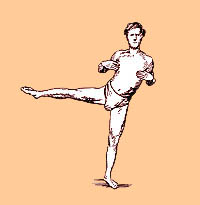 In the Introduction,
Prusik writes, "The
exercises are in four distinct categories: (1) The strengthening of the
whole body, (2) A
flexibility of the joints, (3) The development of equilibrium or
balance, and (4) The mastery of motion . . . "
. He then proceeds to describe his selection of training
calesthenics, beginning with the fingers. In the Introduction,
Prusik writes, "The
exercises are in four distinct categories: (1) The strengthening of the
whole body, (2) A
flexibility of the joints, (3) The development of equilibrium or
balance, and (4) The mastery of motion . . . "
. He then proceeds to describe his selection of training
calesthenics, beginning with the fingers. 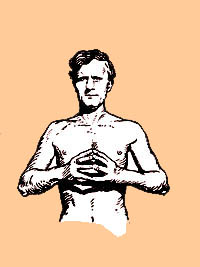 I call this the Prusik Rooster! Although the title of the book encourages the reader to expect German apparatus exercises - after all, Jahn, a German, invented most of the apparatus that are used in gymnastic meets today - such is not the case. This is indeed a minimalist approach, which will bring a chuckle to those modern climbers who are accustomed to campus boards, Bachar Ladders, and artificial climbing walls - as it will to those of us who labored on the rings, rope, high bar, parallel bars, or pommel horse years ago. Virtually no equipment is employed by Prusik, who, I assume, is the model for what might more appropriately be entitled Yoga for Mountaineers. 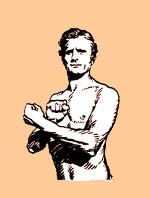 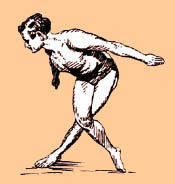 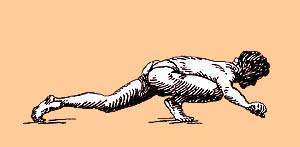 Special thanks to the Alpine Club Library, London |